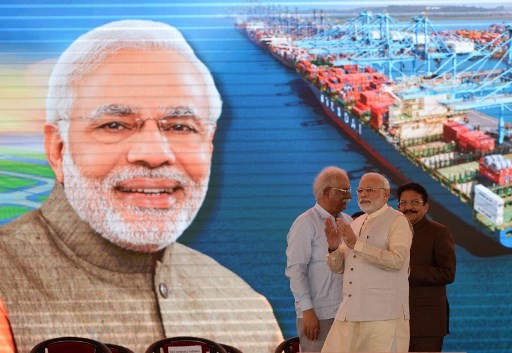Jets set for new home in Mumbai airport after two-decade wait
Change Size
 Indian Prime Minister Narendra Modi (C) gestures as he arrives at the ground breaking ceremony of the new international airport in Navi Mumbai on February 18, 2018.
( AFP/PUNIT PARANJPE )
Indian Prime Minister Narendra Modi (C) gestures as he arrives at the ground breaking ceremony of the new international airport in Navi Mumbai on February 18, 2018.
( AFP/PUNIT PARANJPE )
M
umbai finally started work on a new airport more than two decades after first proposing it, as jets ran out of space to operate in one of the busiest aerodromes using a single runway
On Sunday, Prime Minister Narendra Modi laid the foundation stone of Navi Mumbai International Airport, to be built on about 1,160 hectares (2,866 acres) of land about 35 kilometers (22 miles) southeast of the existing facility. The new airport, expected to handle 60 million passengers annually when fully complete, is running behind schedule with problems ranging from approvals to delays in the bidding process.
“We are trailing behind in infrastructure given the pace at which the aviation sector is growing,” Modi said at the event. “We are trying to press ahead with the speed of execution.”
India has been lagging behind China, Singapore and Dubai among regional hubs in upgrading airports. In 2019, Beijing is due to open a $12.9 billion facility that will become the city’s second mega airport and capable of accommodating more than 75 million passengers with as many as seven runways. In the past two decades, Singapore and Dubai have boosted their capacity, building new terminals and becoming the eastern and western hubs for Indian air travelers.
“There are no more slots in Mumbai,” said Sanjiv Kapoor, chief operating officer at Vistara, the Indian affiliate of Singapore Airlines Ltd. “All the airlines have a hit a wall. It is not good when the commercial capital is not able to add flights. We certainly want to fly more to Mumbai”
The first phase with one runway will be operational by December 2019, handling 10 million passengers a year, according to local officials. India needs to spend as much as 4 trillion rupees ($62 billion) to expand and build new airports over the next decade-and-a-half, but progress has been far slower than what’s needed to manage one of the fastest-growing air travel markets in the world.
The airport, first proposed in 1997 and approved a decade later by India’s cabinet, will be built by a joint venture between a GVK Power & Infrastructure Ltd.-led consortium and state-run former monopoly Airports Authority of India. GVK also operates the current Mumbai airport, which has the capacity to handle 40 million passengers annually.
Last year, the Mumbai airport set a world record handling 969 flights in a 24-hour period, the Times of India reported. That’s the highest for an airport which operates only one runway at any given point in time, it said. The aerodrome is now aiming to reach 1,000 aircraft movements.
Shamefully Late
“It’s an absolute imperative, a must-have for Mumbai,” said Mark Martin, founder and CEO of Dubai-based Martin Consulting LLC. “Mumbai needs a second airport right now, like tomorrow morning, not six to seven years down the line. We have been shamefully late in building a second airport for Mumbai.”
Congestion at the existing facility means an aircraft spends an average 45 minutes to an hour circling the skies during peak hours before finding a landing slot. That compares with about 25 minutes for Singapore and zero for Doha, according to Martin Consulting. Not a single airline managed to land or take off even two thirds of their flights on time in Mumbai in December, data from the regulator show.
Earlier this month, Finance Minister Arun Jaitley said the country plans to increase its airport capacity more than fivefold to help handle a billion trips as carriers in the surging market await delivery of over 900 aircraft. Under the plan, the government plans to connect 56 unserved airports and 31 unserved helipads.
“India needs to significantly increase runway productivity, closer to international benchmarks,” said Kapil Kaul, South Asia CEO at CAPA Centre for Aviation.









